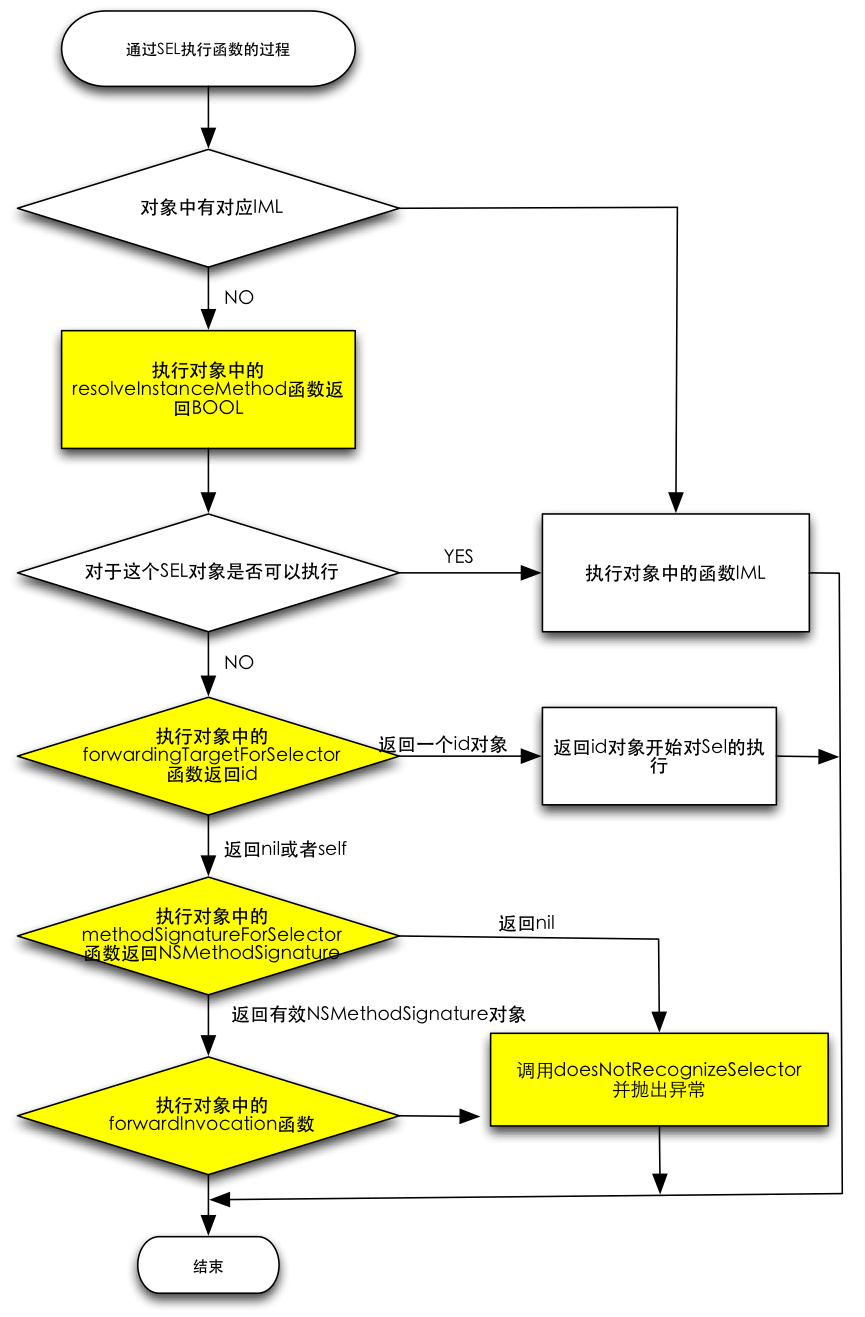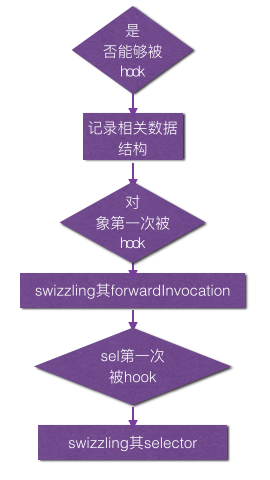面向切面编程之 Aspects 源码解析及应用
最近在做项目的打点统计的时候,发现业务逻辑和打点逻辑经常耦合在一起,这样一方面影响了正常的业务逻辑,同时也很容易搞乱打点逻辑,而且要查看打点情况的时候也很分散,因此想着如何将两者解耦,并将打点逻辑集中起来。其实在 web 编程时候,这种场景很早就有了很成熟的方案,也就是所谓的 aop 编程(面向切面编程),其原理也就是在不更改正常的业务处理流程的前提下,通过生成一个动态代理类,从而实现对目标对象嵌入附加的操作。
在 iOS 中,要想实现相似的效果也很简单,利用 OC 的动态性,通过 swizzling method 改变目标函数的 selector 所指向的实现,然后在新的实现中实现附加的操作,完成之后再回到原来的处理逻辑。想明白这些之后,我就打算动手实现,当然并没有重复造轮子,我在 github 发现了一个基于 swizzling method 的开源框架 Aspects 。这个库的代码量比较小,总共就一个类文件,使用起来也比较方便,比如你想统计某个 controller 的 viewwillappear 的调用次数,你只需要引入 Aspect.h 头文件,然后在合适的地方初始化如下代码即可。
- (void)addKvLogAspect { [self wr_Aspect_hookSelector:@selector(viewWillAppear:) withOptions:AspectPositionAfter usingBlock:^{ KVLog_ReviewTimeline(ReviewTimeline_Open_Tab); }error:NULL]; }
这篇文章主要是介绍 Aspects 源码以及其思路,以及我在实际应用中遇到的一些问题。对 swizzling method 不了解的同学可以先去网上了解一下,下面的内容是基于大家对 swizzling method 有一定的了解的基础上的。
2. 基本原理
我们知道 OC 是动态语言,我们执行一个函数的时候,其实是在发一条消息: [receiver message] ,这个过程就是根据 message 生成 selector,然后根据 selector 寻找指向函数具体实现的指针 IMP,然后找到真正的函数执行逻辑。这种处理流程给我们提供了动态性的可能,试想一下,如果在运行时,动态的改变了 selector 和 IMP 的对应关系,那么就能使得原来的 [receiver message] 进入到新的函数实现了。
那么具体怎么实现这样的动态替换了?
直观的一种方案是提供一个统一入口,如 commonImp ,将所有需要 hook 的函数都指向这个函数,然后在这里,提取相关信息进行转发, JSPatch 实现原理详解 对此方案的可行性有进行分析,对于64位机器可能会有点问题。另外一个方法就是利用 oc 自己的消息转发机制进行转发,Aspects 的大体思路,基本上是顺着这个来的。为了更好的解释这个过程,我们先来看一下消息具体是怎么找到对应的 imp 的,见下图(此图并非原创)。

从上面我们可以发现,在发消息的时候,如果 selector 有对应的 IMP ,则直接执行,如果没有,oc 给我们提供了几个可供补救的机会,依次有 resolveInstanceMethod 、 forwardingTargetForSelector 、 forwardInvocation 。Aspects 之所以选择在 forwardInvocation 这里处理是因为,这几个阶段特性都不太一样: resolvedInstanceMethod 适合给类/对象动态添加一个相应的实现, forwardingTargetForSelector 适合将消息转发给其他对象处理,相对而言, forwardInvocation 是里面最灵活,最能符合需求的。因此 Aspects 的方案就是,对于待 hook 的 selector,将其指向 objc_msgForward / _objc_msgForward_stret ,同时生成一个新的 aliasSelector 指向原来的 IMP,并且 hook 住 forwardInvocation 函数,使他指向自己的实现。按照上面的思路,当被 hook 的 selector 被执行的时候,首先根据 selector 找到了 objc_msgForward / _objc_msgForward_stret ,而这个会触发消息转发,从而进入 forwardInvocation 。同时由于 forwardInvocation 的指向也被修改了,因此会转入新的 forwardInvocation 函数,在里面执行需要嵌入的附加代码,完成之后,再转回原来的 IMP。
3. 源码分析
3.1 数据结构
介绍完大致思路之后,下面将从代码层来来具体分析。从头文件中可以看到使用aspects有两种使用方式:1)类方法 2)实例方法
+ (id<AspectToken>)aspect_hookSelector:(SEL)selector withOptions:(AspectOptions)options usingBlock:(id)block error:(NSError **)error; /// Adds a block of code before/instead/after the current `selector` for a specific instance. - (id<AspectToken>)aspect_hookSelector:(SEL)selector withOptions:(AspectOptions)options usingBlock:(id)block error:(NSError **)error;
两者的主要原理基本差不多,这里不做一一介绍,只是以实例方法为例进行说明。在介绍之前,先介绍里面几个重要的数据结构:
AspectOptions
typedef NS_OPTIONS(NSUInteger, AspectOptions) { AspectPositionAfter = 0, /// Called after the original implementation (default) AspectPositionInstead = 1, /// Will replace the original implementation. AspectPositionBefore = 2, /// Called before the original implementation. AspectOptionAutomaticRemoval = 1 << 3 /// Will remove the hook after the first execution. };
这里表示了 block 执行的时机,也就是额外操作的执行时机,在我的应用场景中就是打点逻辑的执行时机,它可以在原始函数执行之前,也可以是执行之后,甚至可以完全替换掉原来的逻辑。
AspectsContainer
一个对象或者类的所有的 Aspects 整体情况
// Tracks all aspects for an object/class. @interface AspectsContainer : NSObject - (void)addAspect:(AspectIdentifier *)aspect withOptions:(AspectOptions)injectPosition; - (BOOL)removeAspect:(id)aspect; - (BOOL)hasAspects; @property (atomic, copy) NSArray *beforeAspects; @property (atomic, copy) NSArray *insteadAspects; @property (atomic, copy) NSArray *afterAspects; @end
AspectIdentifier
一个 Aspect 的具体内容
@interface AspectIdentifier : NSObject + (instancetype)identifierWithSelector:(SEL)selector object:(id)object options:(AspectOptions)options block:(id)block error:(NSError **)error; - (BOOL)invokeWithInfo:(id<AspectInfo>)info; @property (nonatomic, assign) SEL selector; @property (nonatomic, strong) id block; @property (nonatomic, strong) NSMethodSignature *blockSignature; @property (nonatomic, weak) id object; @property (nonatomic, assign) AspectOptions options; @end
这里主要包含了单个的 aspect 的具体信息,包括执行时机,要执行 block 所需要用到的具体信息:包括方法签名、参数等等
AspectInfo
一个 Aspect 执行环境,主要是 NSInvocation 信息。
@interface AspectInfo : NSObject <AspctInfo> - (id)initWithInstance:(__unsafe_unretained id)instance invocation:(NSInvocation *)invocation; @property (nonatomic, unsafe_unretained, readonly) id instance; @property (nonatomic, strong, readonly) NSArray *arguments; @property (nonatomic, strong, readonly) NSInvocation *originalInvocation; @end
3.2 代码流程
有了上面的了解,我们就能更好的分析整个 apsects 的执行流程。添加一个 aspect 的关键流程如下图所示:
 从代码来看,要想使用 aspects ,首先要添加一个 aspect ,可以通过上面介绍的类/实例方法。关键代码实现如下:
从代码来看,要想使用 aspects ,首先要添加一个 aspect ,可以通过上面介绍的类/实例方法。关键代码实现如下:
static id aspect_add(id self, SEL selector, AspectOptions options, id block, NSError **error) { ... __block AspectIdentifier *identifier = nil; aspect_performLocked(^{ if (aspect_isSelectorAllowedAndTrack(self, selector, options, error)) {//1判断能否hook ...//2 记录数据结构 aspect_prepareClassAndHookSelector(self, selector, error);//3 swizzling } }); return identifier; }
这个过程基本和上面的流程图一致,这里重点介绍几个关键部分。
3.2.1 判断能否被 hook
对于对象实例而言,这里主要是根据黑名单,比如 retain forwardInvocation 等这些方法在外部是不能被 hook ,(对于类对象还要确保同一个类继承关系层级中,只能被 hook 一次,因此这里需要判断子类,父类有没有被 hook,之所以做这样的实现,主要是为了避免出现死循环的出现,这里有相关的讨论)。如果能够 hook,则继续下面的步骤。
3.2.2 swizzling method
这是真正的核心逻辑,swizzling method 主要有两部分,一个是对对象的 forwardInvocation 进行 swizzling,另一个是对传入的 selector 进行 swizzling.
static void aspect_prepareClassAndHookSelector(NSObject *self, SEL selector, NSError **error) { Class klass = aspect_hookClass(self, error); //1 swizzling forwardInvocation Method targetMethod = class_getInstanceMethod(klass, selector); IMP targetMethodIMP = method_getImplementation(targetMethod); if (!aspect_isMsgForwardIMP(targetMethodIMP)) {//2 swizzling method ...// } }
3.2.2.1 swizzling forwardInvocation:
aspect_hookClass 函数主要 swizzling 类/对象的 forwardInvocation 函数,aspects 的真正的处理逻辑都是在 forwradInvocation 函数里面进行的。对于对象实例而言,源代码中并没有直接 swizzling 对象的 forwardInvocation 方法,而是动态生成一个当前对象的子类,并将当前对象与子类关联,然后替换子类的 forwardInvocation 方法(这里具体方法就是调用了 object_setClass(self, subclass) ,将当前对象 isa 指针指向了 subclass ,同时修改了 subclass 以及其 subclass metaclass 的 class 方法,使他返回当前对象的 class。,这个地方特别绕,它的原理有点类似 kvo 的实现,它想要实现的效果就是,将当前对象变成一个 subclass 的实例,同时对于外部使用者而言,又能把它继续当成原对象在使用,而且所有的 swizzling 操作都发生在子类,这样做的好处是你不需要去更改对象本身的类,也就是,当你在 remove aspects 的时候,如果发现当前对象的 aspect 都被移除了,那么,你可以将 isa 指针重新指回对象本身的类,从而消除了该对象的 swizzling ,同时也不会影响到其他该类的不同对象)。对于每一个对象而言,这样的动态对象只会生成一次,这里 aspect_swizzlingForwardInvocation 将使得 forwardInvocation 方法指向 aspects 自己的实现逻辑 ,具体代码如下:
static Class aspect_hookClass(NSObject *self, NSError **error) { ... //生成动态子类,并swizzling forwardInvocation方法 subclass = objc_allocateClassPair(baseClass, subclassName, 0); aspect_swizzleForwardInvocation(subclass);//swizzling forwardinvation方法 objc_registerClassPair(subclass); ... object_setClass(self, subclass);//将当前self设置为子类,这里其实只是更改了self的isa指针而已 return subclass; } ... static void aspect_swizzleForwardInvocation(Class klass) { ... IMP originalImplementation = class_replaceMethod(klass, @selector(forwardInvocation:), (IMP)__ASPECTS_ARE_BEING_CALLED__, "v@:@"); if (originalImplementation) { class_addMethod(klass, NSSelectorFromString(AspectsForwardInvocationSelectorName), originalImplementation, "v@:@") } ... }
由于子类本身并没有实现 forwardInvocation ,隐藏返回的 originalImplementation 将为空值,所以也不会生成 NSSelectorFromString(AspectsForwardInvocationSelectorName) 。
3.2.2.2 swizzling selector
当 forwradInvocation 被 hook 之后,接下来,将对传入的 selector 进行 hook ,这里的做法是,将 selector 指向了转发 IMP ,同时生成一个 aliasSelector ,指向了原来的 IMP ,同时为了放在重复 hook ,做了一个判断,如果发现 selector 已经指向了转发 IMP ,那就就不需要进行交换了,代码如下
static void aspect_prepareClassAndHookSelector(NSObject *self, SEL selector, NSError **error) { ... Method targetMethod = class_getInstanceMethod(klass, selector); IMP targetMethodIMP = method_getImplementation(targetMethod); if (!aspect_isMsgForwardIMP(targetMethodIMP)) { ... SEL aliasSelector = aspect_aliasForSelector(selector);//generator aliasSelector if (![klass instancesRespondToSelector:aliasSelector]) { __unused BOOL addedAlias = class_addMethod(klass, aliasSelector, method_getImplementation(targetMethod), typeEncoding); } class_replaceMethod(klass, selector, aspect_getMsgForwardIMP(self, selector), typeEncoding);// point to _objc_msgForward ... } }
3.2.3 handle ForwardInvocation
基于上面的代码分析知道,转发最终的逻辑代码最终转入 __ASPECTS_ARE_BEING_CALLED__ 函数的处理中。这里,需要处理的部分包括额外处理代码(如打点代码)以及最终重新转会原来的 selector 所指向的函数,其实现代码如下:
static void __ASPECTS_ARE_BEING_CALLED__(__unsafe_unretained NSObject *self, SEL selector, NSInvocation *invocation) { ... // Before hooks. 原来逻辑之前执行 aspect_invoke(classContainer.beforeAspects, info); aspect_invoke(objectContainer.beforeAspects, info); // Instead hooks. BOOL respondsToAlias = YES; if (objectContainer.insteadAspects.count || classContainer.insteadAspects.count) {//是否需要替换掉原来的路基 aspect_invoke(classContainer.insteadAspects, info); aspect_invoke(objectContainer.insteadAspects, info); } else { Class klass = object_getClass(invocation.target); do { if ((respondsToAlias = [klass instancesRespondToSelector:aliasSelector])) { [invocation invoke];//根据aliasSelector找到原来的逻辑并执行 break; } }while (!respondsToAlias && (klass = class_getSuperclass(klass))); } // After hooks. 原来逻辑之后执行 aspect_invoke(classContainer.afterAspects, info); aspect_invoke(objectContainer.afterAspects, info); // If no hooks are installed, call original implementation (usually to throw an exception) if (!respondsToAlias) {//找不到aliasSelector的IMP实现,没有找到原来的逻辑,进行消息转发 invocation.selector = originalSelector; SEL originalForwardInvocationSEL = NSSelectorFromString(AspectsForwardInvocationSelectorName); if ([self respondsToSelector:originalForwardInvocationSEL]) { ((void( *)(id, SEL, NSInvocation *))objc_msgSend)(self, originalForwardInvocationSEL, invocation); } else { [self doesNotRecognizeSelector:invocation.selector]; } } ... }
依次处理 before/instead/after hook 以及真正函数实现。如果没有找到原始的函数实现,还需要进行转发操作。
4. 遇到的问题
以上就是 Apsects 的实现了,接下来会介绍在实际应用过程中遇到的一些问题以及我的解决方案。
4.1 JSPatch 兼容问题
原因
我们的项目中引入了 JSPatch 作为我们的 hot fix方案。 JSPatch 也会 hook 住对象的 forwradInvocation 方法,并且 swizzling 相应的 method ,使其指向转发 IMP ,由于 aspects 也是基于这两者实现的,那么会不会导致问题呢(其实类似的问题也会发生在对象提前被 kvo 了,会不会有影响)?
回过头去看3.2.1 我们先是 hook了 类的 forwardInvocation 使其指向了 __ASPECTS_ARE_BEING_CALLED__ ,然后在 swizzling method 那里,aspect 有做一个判断,如果传入的 selector 指向了转发 IMP ,那么我们什么也不做。因此可想而知,如果传入的 selector 先被 JSPatch hook ,那么,这里我们将不会再处理,也就不会生成 aliasSelector 。
这会导致什么问题了?设想一下,当 selector 被触发的时候,由于 selector 指向了转发 IMP ,因此会进入消息转发过程,同时由于 forwardInvocation 被 aspects 所 hook ,最终会进入到 aspects 的处理逻辑 __ASPECTS_ARE_BEING_CALLED__ 中来。让我们回过头去看看3.2.2中的分析,由于找不到 aliasSelector 的 IMP 实现,因此会在此进行消息转发。而在 3.2.2.1 的分析中我们知道,子类并没有实现 NSSelectorFromString(AspectsForwardInvocationSelectorName) ,所以这里的流程就会进入 doesNotRecognizeSelector ,从而抛出异常。
解决方案
出现上诉问题的原因在于,当 aliasSelector 没有被找到的时候,我们没能将消息正常的转发,也就是没有实现一个 NSSelectorFromString(AspectsForwardInvocationSelectorName) , 使得消息有机会重新转发回去的方法。因此解决方案也就呼之欲出了,我的做法是在对子类的 forwardInvocation 方法进行交换而不仅仅是替换,实现逻辑如下,强制生成一个 NSSelectorFromString(AspectsForwardInvocationSelectorName) 指向原对象的 forwardInvocation 的实现。
static Class aspect_hookClass(NSObject *self, NSError **error) { ... subclass = objc_allocateClassPair(baseClass, subclassName, 0); ... IMP originalImplementation = class_replaceMethod(subclass, @selector(forwardInvocation:), (IMP)__ASPECTS_ARE_BEING_CALLED__, "v@:@"); if (originalImplementation) { class_addMethod(subclass, NSSelectorFromString(AspectsForwardInvocationSelectorName), originalImplementation, "v@:@"); } else { Method baseTargetMethod = class_getInstanceMethod(baseClass, @selector(forwardInvocation:)); IMP baseTargetMethodIMP = method_getImplementation(baseTargetMethod); if (baseTargetMethodIMP) { class_addMethod(subclass, NSSelectorFromString(AspectsForwardInvocationSelectorName), baseTargetMethodIMP, "v@:@"); } } ... }
注意如果 originalImplementation 为空,那么生成的 NSSelectorFromString(AspectsForwardInvocationSelectorName) 将指向 baseClass 也就是真正的这个对象的 forwradInvocation ,这个其实也就是 JSPatch hook 的方法。同时为了保证 block 的执行顺序(也就是前面介绍的 before hooks / instead hooks / after hooks ),这里需要将这段代码提前到 after hooks 执行之前进行。这样就解决了 forwardInvocation 在外面已经被 hook 之后的冲突问题。
4.2 remove操作
4.2.1 单个aspect remove
单个 aspect 的 remove 貌似有个问题,先来看看源码。
if (aspect_isMsgForwardIMP(targetMethodIMP)) { SEL aliasSelector = aspect_aliasForSelector(selector); Method originalMethod = class_getInstanceMethod(klass, aliasSelector); IMP originalIMP = method_getImplementation(originalMethod); if (originalIMP) { class_replaceMethod(klass, selector, originalIMP, typeEncoding); } }
当你对某个 aspect 执行 remove 操作的时候,它会直接 replace 这个 selector 的 IMP,这个操作是对整个类的所有实例都生效的,这会导致什么问题呢?
以类 A 为例,你先进入了 A 的一个实例 A1 ,hook 住了方法 selector1 ,然后,并没有销毁这个实例的时候,通过其他路径又进入类 A 的另一个实例 A2 ,当然也 hook 了 selector1 ,然后这个时候,如果你 A2 中执行了这个 aspect 的 remove 操作,按照上面的逻辑,类 A 的 selector1 将会恢复正常,可像而知,当你退回 A1 的时候, A1 的 aspect 将会失效。这里其实我的解决思路很简单,因为在执行 remove 操作的时候,其实和这个对象相关的数据结构都已经被清除了,即使不去恢复 selector1 的执行,在进入 __ASPECTS_ARE_BEING_CALLED__ 由于这个没有响应的 aspects ,其实会直接跳到原来的处理逻辑,并不会有其他附加影响。
4.2.2 整个对象aspect remove
还有一个问题就是,aspects 的 remove 操作只能支持单个的 remove 操作,不支持一次性删除一个对象的所有 aspects 。这里,也做了一个扩展,对原来的 aspects 进行扩展,实现了一次性 remove 一个对象所有 aspects 的方法。











![[HBLOG]公众号](https://www.liuhaihua.cn/img/qrcode_gzh.jpg)

